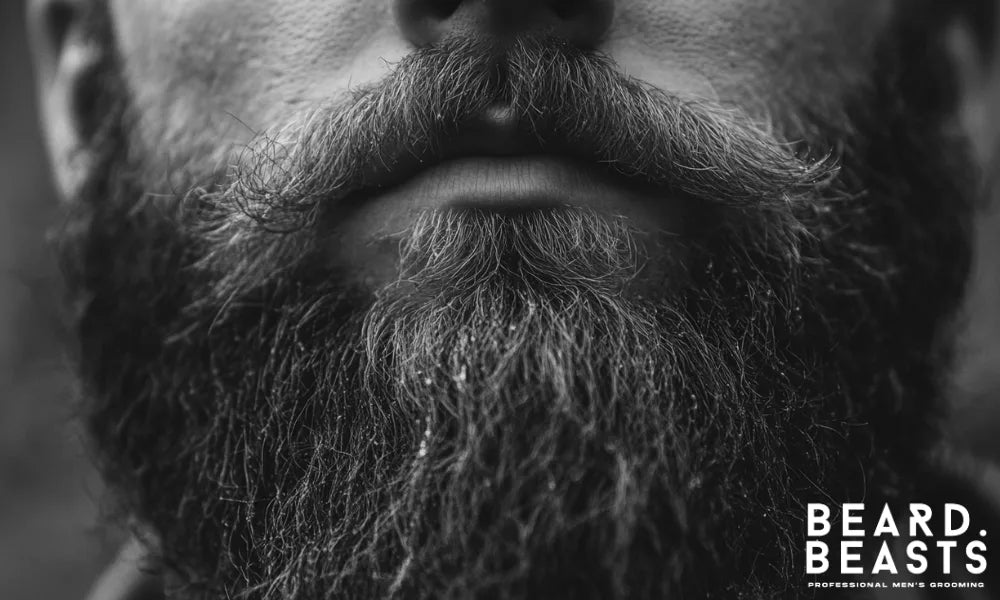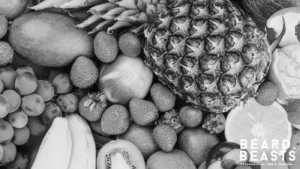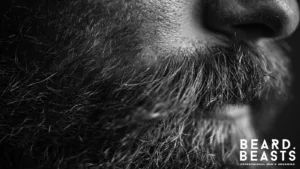Beard dandruff. Two words every bearded man dreads. Those stubborn white flakes can ruin an otherwise well-groomed beard, leaving it itchy, irritated, and far from its best. But the good news is simple — learning how to get rid of beard dandruff isn’t complicated.
This guide breaks down everything you need to know. You’ll learn what triggers flakes, how to recognize the early signs, and the most effective steps to eliminate them for good.
Backed by grooming expertise and practical care strategies, Beard Beasts shows you how to restore a balanced, healthy beard — free from flakes and discomfort.
What Is Beard Dandruff (and Why It Happens)
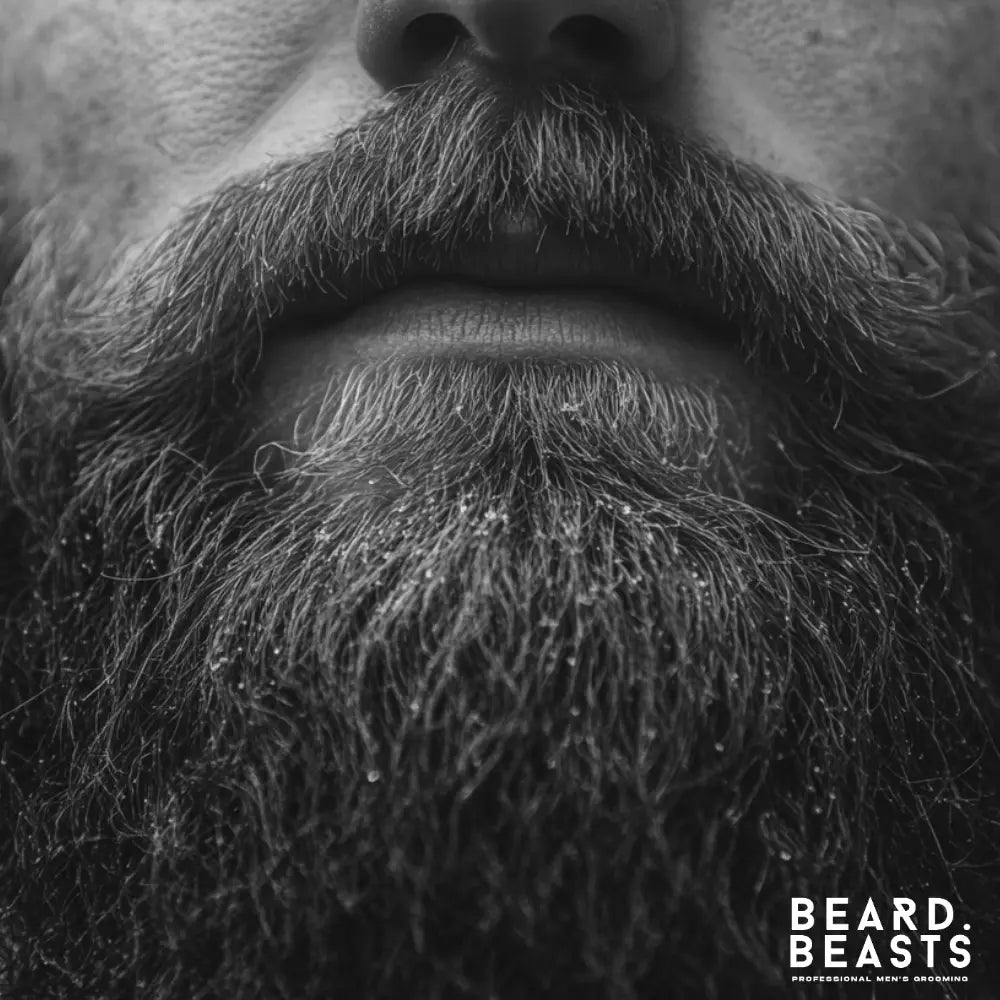
This issue is more than just dry flakes caught in your beard — it’s a sign that the skin beneath your beard is struggling. When the skin becomes dehydrated, irritated, or imbalanced, it starts to shed faster than normal, creating visible flakes that cling to your facial hair.
This condition often appears when your beard routine neglects the skin underneath. While the hair may look fine, the foundation — your skin — is inflamed or lacking moisture. Restoring that balance is what gets rid of beard dandruff for good.
Dry Skin vs. Beard Dandruff
Dry skin beneath the beard usually results from environmental factors like cold weather or overwashing. The flakes are light, powdery, and the skin feels tight.
Beard dandruff, however, is often linked to seborrheic dermatitis, a mild fungal condition caused by Malassezia, a yeast that naturally lives on your skin. When oil, sweat, and dead cells build up, this fungus multiplies, leading to thicker, oily flakes and redness.
Knowing whether you’re dealing with dryness or dandruff helps you treat it correctly. Dry skin needs moisture. Dandruff needs balance — cleaning away buildup, calming irritation, and maintaining healthy oils.
Causes of Beard Dandruff
Several factors contribute to beard dandruff. The most common include:
Using harsh cleansers: Regular soaps or shampoos strip away natural oils, leaving your beard dry and itchy.
Cold, dry weather: Low humidity draws moisture from your skin, increasing flaking.
Neglecting beard hygiene: Failing to wash or exfoliate traps oil, sweat, and dead skin beneath the hair.
Product buildup: Heavy or synthetic products clog pores, worsening irritation.
Poor hydration and nutrition: Lack of water and essential fats leads to dehydrated skin.
Understanding what causes your flakes is the first step toward fixing them. Once you address the root trigger, every product and technique that follows becomes far more effective.
Recognizing the Signs of Beard Dandruff
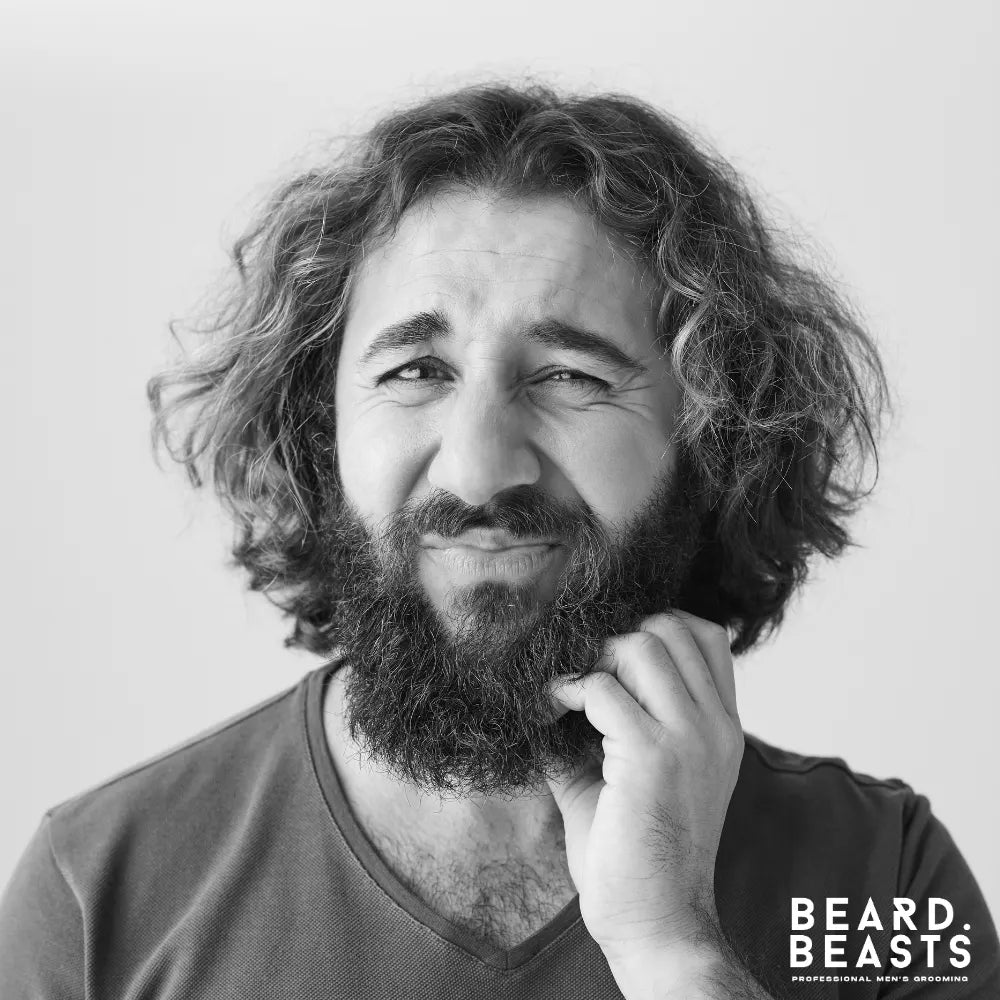
Beard dandruff shows itself in ways that are easy to overlook at first. Knowing what to watch for helps you act early and prevent the problem from escalating.
Flakes in the Beard
The most visible sign is the appearance of white or yellow flakes caught near the roots or falling onto your shirt. Light, dusty flakes point to dryness, while heavier, oily flakes often indicate fungal buildup beneath the skin.
Itching and Redness
Persistent itching or mild redness signals inflammation. This happens when the skin barrier is compromised, often from dryness or irritation. Scratching only worsens it by stripping away protective oils.
Dull, Coarse Beard Hair
When the skin beneath your beard is unhealthy, the hair itself suffers. It can feel rough and look lifeless because the follicles aren’t getting proper nourishment.
Tightness After Washing
If your beard feels tight or the skin stings after washing, it’s a sign your cleanser is too harsh or your skin is dehydrated. Without proper moisture, flakes will continue to form.
Recognizing these signs gives you clarity before treatment begins. Once you know what you’re facing, you can target the problem with precision.
Step-by-Step: How to Get Rid of Beard Dandruff
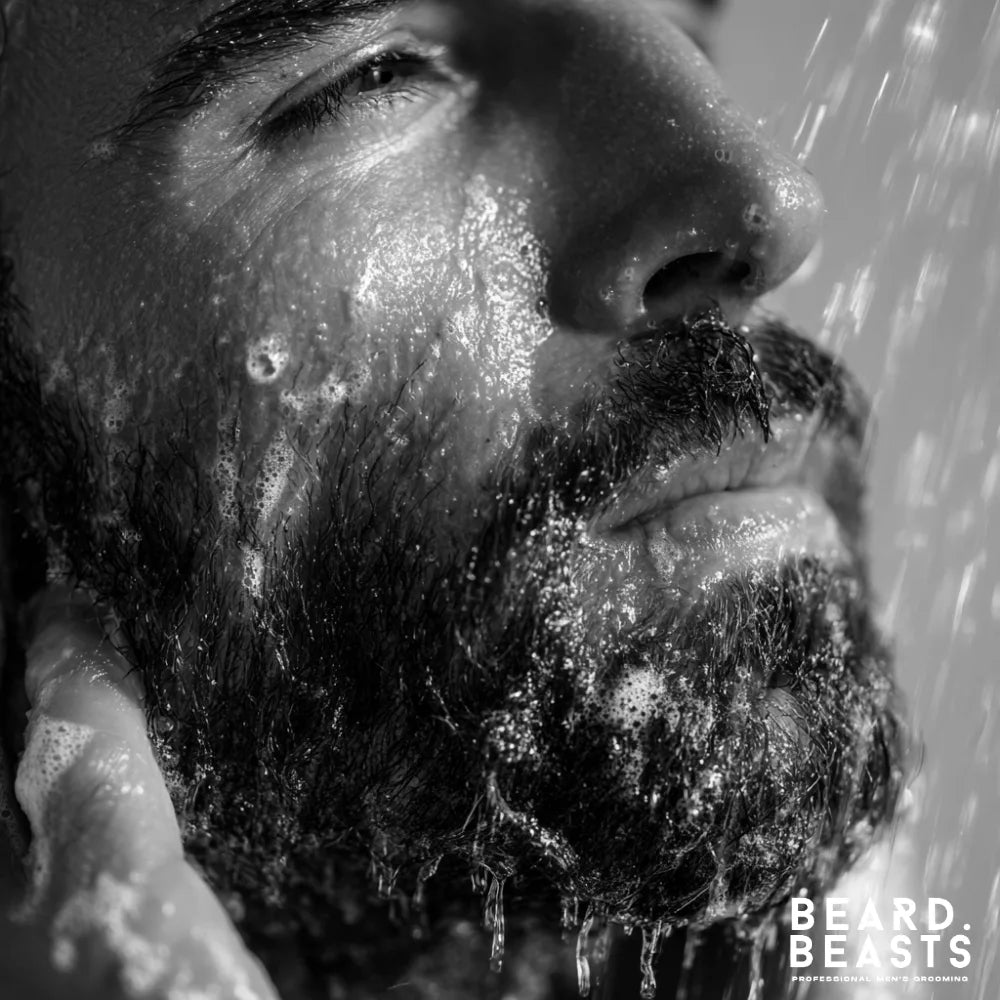
Getting rid of beard dandruff isn’t complicated — it’s about consistency and the right method. This routine removes buildup, restores hydration, and keeps the skin beneath your beard healthy and balanced.
Step 1: Wash Your Beard the Right Way
Your first move is to replace harsh soaps with a gentle, pH-balanced beard wash. Ordinary shampoos strip your skin’s natural oils, making flakes worse.
How to do it:
Use lukewarm water to open pores without drying the skin.
Massage the beard wash into the skin beneath your beard with your fingertips.
Rinse thoroughly and pat dry with a towel.
Wash two to three times per week — overwashing causes irritation.
Step 2: Exfoliate Dead Skin and Product Buildup
Exfoliation clears away trapped oil, dead cells, and residue that block pores. Use a soft beard brush or an exfoliating scrub designed for facial use.
Routine tips:
Exfoliate once or twice per week — no more.
Brush gently in circular motions to avoid damaging the skin.
Always follow with beard oil to replenish moisture.
Step 3: Apply Beard Oil Daily
Beard oil is essential for hydration and balance. It nourishes both the beard and the skin beneath, preventing dryness and flaking.
Look for:
Jojoba oil – mimics natural sebum, prevents dryness.
Argan oil – restores softness and elasticity.
Tea tree oil – antifungal properties target Malassezia.
Warm a few drops between your palms, work it through from roots to ends, and ensure it reaches the skin.
Step 4: Lock in Moisture with Beard Balm or Butter
After applying beard oil, use a light balm or beard butter to seal in hydration. Beeswax and butters form a protective barrier that prevents irritation.
This step also gives your beard structure while supporting long-term skin health.
Step 5: Maintain Consistent Grooming Habits
Beard dandruff won’t return if you stay disciplined with your routine. Keep your tools clean, wash regularly, and never skip hydration.
Trim occasionally to improve airflow through your beard — healthy skin thrives on consistency.
Following this process keeps both your beard and skin in balance. Within a few weeks, flakes fade, the itch subsides, and your beard regains its natural texture and strength.
Best Ingredients for Fighting Beard Dandruff
The right ingredients make all the difference when it comes to getting rid of beard dandruff. Each one serves a specific purpose — from restoring balance to fighting irritation and supporting long-term beard health.
Key ingredients to look for:
Tea Tree Oil: Natural antifungal that targets Malassezia and reduces inflammation.
Jojoba Oil: Mimics natural sebum, restores moisture, and strengthens the skin barrier.
Argan Oil: Rich in vitamin E and fatty acids; calms redness and softens coarse hair.
Shea Butter: Deeply hydrates and locks in moisture with a light protective layer.
Vitamin E: Repairs irritation and improves the skin’s resilience against dryness.
Aloe Vera: Soothes inflammation, delivers lightweight hydration, and promotes healing.
When combined, these ingredients create a foundation of nourishment and defense. They protect against dehydration, regulate oil production, and maintain the conditions your beard needs to stay healthy and flake-free.
Beard Care Mistakes That Make Dandruff Worse

Even with good intentions, certain habits can undo your progress and keep flakes coming back. Recognizing these mistakes helps you correct them before they become part of your routine.
Common mistakes to avoid:
Using harsh cleansers: Regular shampoos and soaps strip the natural oils your beard needs, leaving the skin dry and unprotected.
Overwashing your beard: Washing too often disrupts your skin’s oil balance, leading to irritation and increased flaking.
Skipping hydration: Failing to apply beard oil or balm after washing leaves the skin vulnerable and tight.
Ignoring product buildup: Applying new layers of oil or balm without cleaning first traps sweat, dirt, and dead skin beneath the beard.
Using synthetic or alcohol-based products: These cause unnecessary irritation and dryness that worsen dandruff.
Neglecting grooming tools: Dirty brushes or combs reintroduce bacteria and oil back into your beard, creating a cycle of irritation.
Every one of these mistakes disrupts your beard’s natural equilibrium. Once you eliminate them, your products work as intended — soothing, protecting, and keeping the skin beneath your beard healthy.
Long-Term Prevention and Maintenance
Once you’ve cleared beard dandruff, the goal shifts from treatment to prevention. Keeping your beard healthy is about discipline — consistent care that supports the skin’s balance day after day.
Follow these long-term strategies:
Stay consistent with your routine: Wash, exfoliate, and hydrate regularly. Dandruff often returns when grooming habits become inconsistent.
Hydrate from within: Drink plenty of water and maintain a diet rich in healthy fats. Internal hydration supports external balance.
Adjust for climate and season: Cold, dry weather demands richer hydration, while warmer months call for lighter products and regular cleansing.
Keep your tools clean: Wash brushes and combs weekly to prevent bacteria and oil buildup.
Avoid product overload: Using too many products at once clogs pores and disrupts your skin’s natural rhythm.
Protect your beard from harsh conditions: If you’re often exposed to sun, wind, or salt water, rinse and reapply oil afterward to maintain hydration.
By following these habits, you’ll prevent flakes, maintain soft, healthy growth, and protect your beard’s long-term strength. A disciplined approach doesn’t just stop dandruff — it defines the way your beard looks and feels every day.
When to See a Dermatologist

Most cases of beard dandruff can be managed through consistent care and the right products. However, when flakes persist despite your best efforts, it’s time to seek professional advice.
You should consider seeing a dermatologist if:
Dandruff continues for several weeks even after following a structured routine.
The skin beneath your beard becomes red, swollen, or painful.
You notice greasy, yellowish scales forming along the hairline or eyebrows.
You experience oozing, cracking, or bleeding skin.
Over-the-counter treatments cause burning, irritation, or discomfort.
A dermatologist can determine whether you’re dealing with seborrheic dermatitis, psoriasis, or eczema, all of which may look similar but require targeted treatment. They can also prescribe medicated shampoos or antifungal creams that resolve deeper irritation.
Knowing when to involve a professional isn’t a setback — it’s a disciplined move toward lasting results. Addressing the issue early ensures your beard stays healthy, strong, and worthy of the effort you’ve put into it.
Final Thoughts
Learning how to get rid of beard dandruff isn’t about finding a quick fix — it’s about building a routine that keeps your skin and beard healthy over time. With the right care, you can eliminate flakes, calm irritation, and maintain a beard that feels as good as it looks.
Consistency is the real solution. Wash with a gentle beard cleanser, exfoliate weekly, and hydrate daily using natural ingredients like jojoba oil, tea tree oil, and shea butter. These steps form a reliable beard dandruff treatment that restores moisture and protects against future dryness.
Every man experiences the occasional setback — dehydrated skin, irritation from weather, or product buildup — but the difference lies in how you respond. Treat your beard with the same discipline you apply to the rest of your routine, and the results will speak for themselves.
Your beard reflects the care behind it. Keep it healthy, stay consistent, and remember: the foundation of a strong beard begins with healthy skin beneath it.

